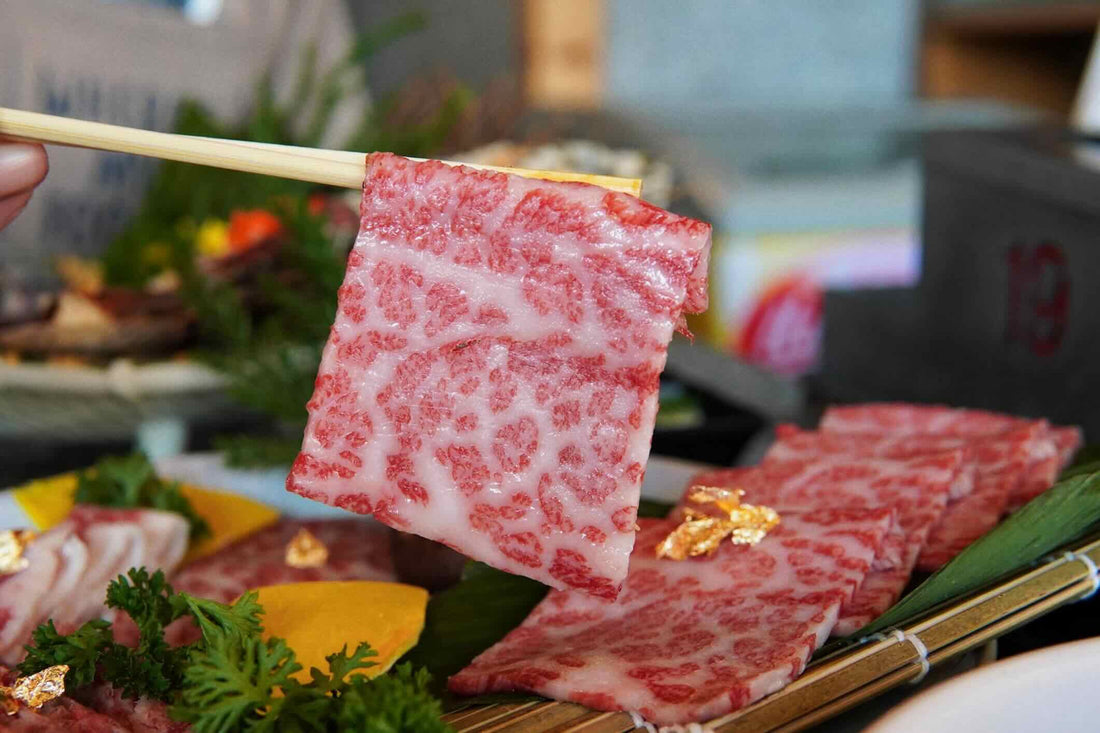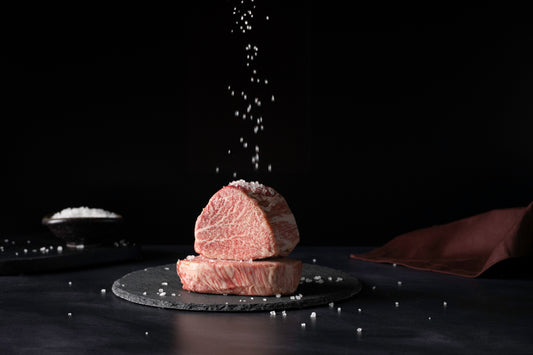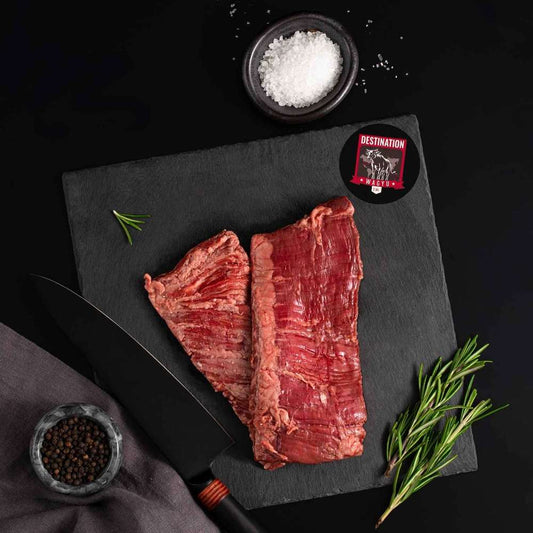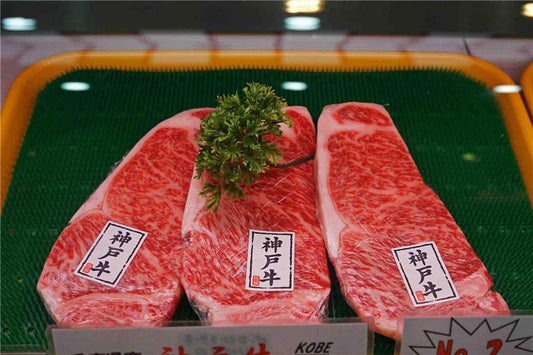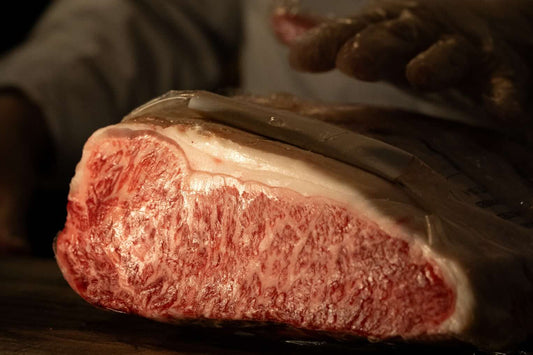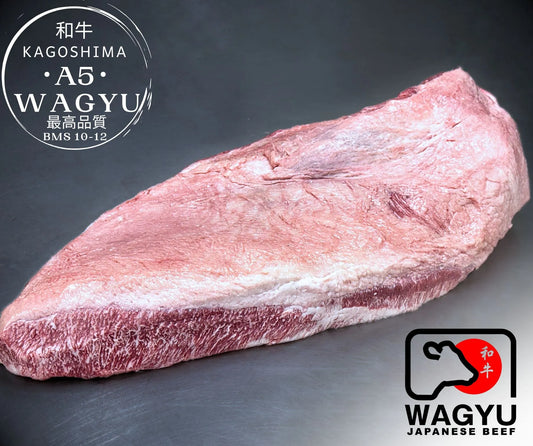Understanding the genetic makeup of Wagyu is non-negotiable if you're working with A5 beef at a professional level. This isn't just about knowing that "Wagyu means Japanese cow." It's about recognizing how specific heritable traits, carefully preserved and cultivated over generations, create a beef product that behaves unlike any other. The Kuroge Washu, or Japanese Black, is the breed responsible for the vast majority of A5 Wagyu. But even within that breed, there are bloodlines that differ profoundly in their outcomes on the plate. If you're buying, aging, or serving Wagyu, you need to know not just the breed but also the lineage. This understanding enables better decisions on sourcing, menu design, and even training kitchen staff to respect what they're working with.
The Tajima line, in particular, is prized for its ability to produce extraordinary intramuscular fat with an unusually fine dispersion throughout the muscle tissue. These cattle are smaller in frame, and their carcasses yield less total meat compared to other lines like Kedaka or Fujiyoshi. But what they lack in volume, they more than make up for in quality. I’ve worked with Tajima-derived A5 striploins that were so densely webbed with marbling they required a scalpel-like approach to butchery. On the other hand, Kedaka cattle tend to produce larger ribeyes with coarser marbling and more pronounced muscle fiber definition. These cuts behave differently during cooking. They sear more like a cross between Wagyu and USDA Prime, which makes them an excellent choice when you want richness with a touch more bite.
What distinguishes Wagyu at the molecular level is its unique expression of specific genetic markers. The SCD gene (Stearoyl-CoA desaturase) influences how much monounsaturated fat the animal produces, particularly oleic acid, which gives Wagyu its signature soft texture and sweet, buttery flavor. Animals with higher expression of the SCD gene exhibit fat that literally melts in your mouth, often at or just below human body temperature. That’s not poetic; it’s a measurable biochemical reality. Similarly, the FASN gene (Fatty Acid Synthase) regulates the synthesis of fatty acids themselves. The best breeders in Japan, especially in Kagoshima and Miyazaki, select breeding stock with specific genotypes that optimize these traits. When you get a cut with BMS 11 or 12, you're not just looking at the result of good feeding. You're seeing genetic engineering through generations of intentional selection.
For those of us running kitchens or butchery programs, understanding these traits isn't about academic curiosity. It's about performance. Fatty acid profiles affect not just taste but also cook time, browning potential, and resting behavior. Meat from Tajima cattle with high SCD expression will behave differently under heat than a generic Wagyu-Angus cross. It will caramelize faster, render more quickly, and can even separate if you're not managing temperature with precision. If you're applying dry heat without fully understanding the lipid structure, you can easily overshoot your target temperature before you even see a proper sear. That’s the kind of mistake that turns a $300 steak into a liability.
Genetics also affect the culinary language you use with your team and your guests. When we talk about “A5 Wagyu,” we often lump it into one box. But the real professionals, those building programs around beef tasting menus or pursuing Michelin-level execution, should be asking what line it came from, what markers it carries, and how that affects both handling and plating. There is no such thing as generic Wagyu. Like wine, coffee, or cheese, terroir and lineage mean everything. Once you start treating it that way, your results, your margins, and your guest satisfaction all improve dramatically.

Japanese Grading & Certification Protocols
If you're serious about working with A5 Wagyu, you must become fluent in the Japanese grading system. This means understanding not just the letter and number combination printed on the box, but also what it actually represents and how it’s determined. Most chefs I train or consult for initially assume A5 is simply a top-tier stamp. In reality, it’s far more nuanced. The designation reflects a multi-dimensional evaluation system established by the Japanese Meat Grading Association (JMGA), and each component of that evaluation influences what you can expect from the beef when it hits your board or your grill. If you're making purchasing decisions based solely on the "A5" label, you could be overlooking critical information that may determine the success of your dish.
Let’s begin with the two parts of the grade: yield and quality. The yield grade is represented by the letter (A, B, or C) and indicates how efficiently the carcass converted live weight into usable meat from the primary cuts such as ribeye, sirloin, and tenderloin. This is not a cosmetic score. An “A” yield reflects a higher-than-average percentage of retail cuts, while “B” and “C” indicate slightly less. However, a lower yield grade does not always equate to an inferior product. In fact, I’ve worked with B5 Wagyu that outperformed some A5 cuts in eating quality because the marbling and fat integration were more balanced. That’s why understanding the context and your specific culinary needs is more important than automatically pursuing the highest yield.
The second part of the grade is the quality score, which ranges from 1 to 5. This is where most of the nuance lies. The quality score is a composite based on four independent criteria: Beef Marbling Score (BMS), meat color and brightness, firmness and texture of the muscle, and fat color, luster, and quality. Each element is scored separately using a detailed chart, and the final grade is determined by the lowest individual score. For example, if a carcass receives perfect 5s for marbling, color, and fat quality but a 4 for texture, it will not qualify as a 5 overall. This level of consistency is part of what makes the Japanese grading system so reliable. In my opinion, no other beef grading framework holds producers to such rigorous standards across such a broad range of sensory and physical factors.
Now let’s focus on the component that receives the most attention: the BMS, or Beef Marbling Score. This is arguably the most visually striking aspect of A5 Wagyu. The BMS ranges from 1 to 12 and measures the quantity and distribution of intramuscular fat, particularly in the ribeye area between the sixth and seventh rib. To qualify as A5, the beef must have a BMS between 8 and 12. In practice, a BMS of 8 presents clean, snowflake-like marbling with moderate dispersion, while a BMS of 12 looks almost like white lace against a faint pink background and melts at the touch of a knife. I’ve worked with BMS 12 beef that required a nearly frozen blade to slice cleanly without displacing the fat. Still, more marbling isn't always better. It must be considered in context. For a 20-course kaiseki menu, BMS 12 in 30-gram portions is ideal. But if you’re serving 150-gram steaks à la carte, you might find BMS 9 offers better balance and is more sustainable for the diner’s palate.
It’s also worth noting that marbling evaluation is increasingly supported by digital imaging systems in addition to visual scoring by trained experts. These technologies allow for finer distinctions in fat distribution and help maintain consistency across regions. Even so, traditional graders, many of whom undergo years of training still play a crucial role. I’ve observed graders on the floor of the Osaka meat market as they assess a carcass in seconds by touch and sight, delivering judgments with astonishing accuracy. If you ever have the chance to witness this process in Japan, I highly recommend it. It will forever change how you view beef.
Of course, grading is only part of the story. Verification and traceability are what truly distinguish the Japanese system. Every certified Wagyu animal receives a unique 10-digit ID recorded in Japan’s national cattle database. This ID can track everything from breed lineage and place of birth to feed regimen, farm of origin, slaughterhouse, and final grade. Many producers include this documentation often referred to as a “nose print” certificate, with each primal or box, especially for exports. In high-end settings, I display this certificate on a sideboard or pass it to the service team to present at the table. When a guest learns their ribeye came from a 34-month-old Tajima steer raised in Kobe on a barley-rich diet, it elevates the dining experience in a way that no menu description can match.
In some instances, traceability now incorporates blockchain-backed systems to provide immutable records of origin and handling. These innovations are not just marketing tools. They are becoming essential in a global market where the term “Wagyu” is often misused to describe any well-marbled beef. I’ve seen crossbred products from the U.S. and Australia labeled as “Wagyu” without any clarification regarding breed purity, grade, or provenance. For culinary professionals, this lack of transparency poses both ethical and practical risks. When serving A5, it is vital to work with suppliers who can provide full documentation to support every claim.
Grading and verification protocols should not be viewed as bureaucratic hurdles. They are essential tools that preserve the integrity of the product and your credibility as a professional. In my kitchens, we treat the A5 designation with the utmost respect. It signals to both the team and the diner that this A5 Wagyu steak is something extraordinary. It requires different preparation, different service, and a deeper level of appreciation. That respect begins with understanding exactly how and why the beef earned the label.
Flavor Science and Sensory Mechanics
The defining feature of A5 Wagyu steak, and the reason it commands such reverence in culinary circles, is its extraordinarily rich and nuanced flavor profile. This flavor is engineered not simply through genetics or feeding, but through fat chemistry, thermal dynamics, and careful aging. For years, I approached Wagyu like any premium beef, until I realized that treating A5 like a USDA Prime steak results in culinary failure. The science behind Wagyu is what demands a completely different cooking philosophy. Once you understand that, the steak stops being just a piece of meat and becomes a vessel for layered sensory design.
At the heart of Wagyu’s flavor profile is its fat composition. Unlike typical beef, which has a higher proportion of saturated fatty acids, Wagyu fat is dominated by monounsaturated fatty acids (MUFAs), especially oleic acid (C18:1). Some A5 Wagyu cuts, particularly from Miyazaki and Kagoshima, contain over 55% oleic acid in their lipid profile. This single chemical attribute explains both the silky mouthfeel and the distinct sweetness that characterizes the fat. It also affects cooking. Oleic acid melts at around 22 to 25°C, which is well below the average human body temperature. As a result, the fat literally begins to melt on your tongue before you even start chewing. That’s not just pleasant; it’s structurally significant. It reduces chew-down fatigue, coats the palate, and provides a prolonged, luxurious finish.
But flavor isn’t just about fat. It’s also about the Maillard reaction, a complex series of heat-induced reactions between amino acids and reducing sugars that create thousands of flavor compounds during cooking. With A5 Wagyu, this process happens more quickly and becomes more volatile due to the fat’s high thermal conductivity. The marbling accelerates browning but can also cause the muscle to heat unevenly if you're not careful. I ruined perfectly good cuts early in my career by over-searing the outside while the center turned into a rendered pool. Now, I treat Wagyu with surgical control, using minimal exposure to direct heat, often just enough to caramelize the surface and trigger that first wave of aromatic volatiles.
Those volatiles are part of what makes the aroma of Wagyu so distinctive. As oleic acid oxidizes at the sear point, it produces aldehydes and ketones that interact with nitrogenous compounds from the muscle. This creates a layered scent that includes notes of sweet cream, roasted nuts, toasted grains, and a mild floral component. In contrast, dry-aged USDA beef tends to produce aromas that lean into umami and blue cheese notes. This difference highlights why Wagyu requires a different set of accompaniments. I’ve paired A5 with everything from kombu butter to citrus ash, and every time I’m reminded how sensitive the fat is to external flavors. It magnifies everything it touches, whether positive or negative.
Texture is equally important. Due to the incredibly fine marbling, the muscle fibers in Wagyu are more loosely organized, which reduces resistance during the bite. In a properly finished A5 striploin, there is virtually no connective tissue remaining, meaning even the lean muscle melts almost instantly. This is where overcooking becomes a real hazard. Unlike conventional beef, which gains succulence from gentle sous-vide or extended resting, Wagyu begins to lose its character as soon as the internal temperature climbs above 54°C. The fat renders too quickly, leaks out, and leaves you with a rich but oddly hollow chew. I find that a 52°C internal target, combined with brief high-temperature contact on a heavy pan or a binchotan grill, creates the ideal balance of crust and creamy interior.
There is also the matter of umami and glutamate synergy. Wagyu muscle contains elevated levels of glutamic acid and inosinic acid, two of the primary contributors to umami flavor. These compounds become more prominent during controlled aging, particularly in wet-aged cuts stored between 0.5°C and 1.5°C for 30 to 40 days. I’ve conducted side-by-side tastings between freshly slaughtered Wagyu and aged Wagyu of the same grade, and the difference in finish and savoriness is profound. The aged version delivers a deeper, more resonant umami note that lingers and evolves on the palate. This effect becomes especially noticeable when Wagyu is paired with fermented ingredients like miso, shio koji, or aged soy. The synergy between these umami sources intensifies the flavor, creating a lasting fifth taste that elevates the entire dish.
In professional settings, these sensory traits should be evaluated with rigor rather than guesswork. I’ve worked with culinary labs and R&D kitchens where descriptive analysis panels and Temporal Dominance of Sensations (TDS) are used to map how flavor perceptions unfold over time. These aren’t just academic exercises, they are practical tools for designing multi-course experiences. If your first bite of Wagyu is creamy, the second savory, and the third fatty to the point of fatigue, you need to develop supporting elements that manage that progression. A proper bite of A5 Wagyu should rise, peak, and fall cleanly, leaving the diner satisfied rather than overwhelmed.
That’s why palate cleansers, acid-driven garnishes, and contrasting textures are not optional. They are essential. A few grams of grated daikon or a brush of sudachi juice can reset the tongue and prepare it for the next bite. I’ve even used oolong tea granita between courses to refresh guests’ perception of fat. These may sound like stylistic flourishes, but I consider them part of the flavor engineering process. They are necessary tools for balancing one of the most potent proteins in the culinary world.
Understanding the science and sensory mechanics behind A5 Wagyu steaks isn’t just about cooking better steaks. It’s about controlling the guest’s experience at a molecular level. When we talk about the steak "melting in your mouth," we are describing a biochemical interaction between protein, fat, and temperature. When we say the flavor "lingers," we are referring to specific umami compounds and lipid oxidations that remain on the palate. This kind of knowledge gives you precision, and precision is what separates a good Wagyu dish from a transcendent one.

Preparation Methodology and Cooking Techniques
The moment A5 Wagyu hits the heat, everything you think you know about steak cookery must shift. The muscle and fat architecture of this beef are so structurally and chemically different from conventional beef that standard methods, whether from classical French, modernist, or New World schools, are often inadequate or even detrimental. I've spent years refining a Wagyu-specific preparation methodology that treats the product less like steak and more like an ultra-fatty fish or foie gras. It’s not about reinventing the wheel, but about reengineering the thermal process with a precise, minimalist mindset.
Let’s start with aging, because it plays a fundamental role in the behavior of the beef under heat. Dry-aging is generally the default in high-end Western kitchens for beef, prized for its enzyme-driven umami concentration and textural enhancement. But with A5 Wagyu, dry-aging becomes far riskier. The very trait that makes Wagyu exceptional is its high unsaturated fat content which also makes it more prone to oxidative rancidity. I’ve experimented with 30, 45, and even 60-day dry-aged Wagyu primals in controlled environments, and the longer the aging, the more challenging it becomes to preserve the integrity of the fat. After about 30 days, especially in high-BMS cuts, you begin to lose the clean, creamy flavor that defines top-tier Wagyu. Instead, the fat takes on a slightly waxy, metallic edge, something I’ve confirmed in blind tastings with professional panels.
Wet-aging, by contrast, is a more suitable approach for most A5 cuts. Vacuum-sealed primals held at just above freezing (0.5 to 1.5°C) for 28 to 45 days benefit from enzymatic tenderization without the oxidation risk. The muscle fibers soften, the flavor deepens slightly, and the fat remains clean and sweet. Wet-aged Wagyu also trims more cleanly, allowing for better visual presentation and more uniform searing. For striploins and tenderloins, I tend to wet-age up to 40 days. For chuck and secondary cuts like zabuton or misuji, I might go slightly shorter to preserve their more delicate fat structures.
When it comes to cooking, the central challenge is managing thermal conductivity. Wagyu fat conducts heat faster than muscle tissue, and its melting point is dramatically lower. As a result, if you treat A5 like a Prime ribeye and give it 2 to 3 minutes per side on a hot pan, you’ll liquefy the internal fat and end up with a greasy, collapsed texture. The best analogy I can offer is foie gras: brief, intense heat with precise resting. My baseline technique for most A5 Wagyu steaks under 60 grams is a reverse sear or plancha flash sear at extremely high heat, sometimes as high as 275°C on a carbon steel surface. I sear for 12 to 20 seconds per side, no more. Any longer and the internal temperature climbs too fast, destabilizing the fat matrix.
Sous-vide, which I initially resisted for Wagyu, has proven valuable in specific use cases, especially for portions thicker than 15 mm. I sous-vide A5 striploin at 52°C for 15 to 20 minutes, depending on thickness, then finish with a hard sear on binchotan or a dry plancha. This gives me complete control over internal texture while still delivering the crisp Maillard surface that guests expect. However, sous-vide must be carefully calibrated. Overcooking Wagyu by even 2 degrees can alter its entire character, resulting in grainy fat and mushy mouthfeel. Unlike conventional beef, where medium-rare has a degree of forgiveness, A5 Wagyu has a razor-thin optimal temperature window between 50°C and 54°C.
Another critical element is surface preparation. Because Wagyu fat begins to melt at body temperature, excess surface moisture becomes an enemy. It inhibits Maillard browning and encourages steaming rather than searing. My standard practice is to air-dry all portions in a walk-in cooler, uncovered on a rack, for 6 to 12 hours before service. This not only enhances separability but also firms up the surface, allowing for cleaner cuts post-cooking. I never season Wagyu before searing. Salt draws moisture to the surface, which disrupts browning. Instead, I apply fine sea salt or flaked Maldon salt immediately after resting, when the surface is dry, warm, and receptive.
Fat retention during resting is another unique feature of Wagyu cookery. Because the fat has such a low melting point, traditional 10-minute resting periods (used to redistribute juices in standard steaks) will often cause Wagyu portions to leak fat if left on warm plates or surfaces. Instead, I rest Wagyu on a cooling grid over paper, just long enough - 2 to 3 minutes for a 60-gram cut, 4 to 5 minutes for anything larger. This approach prevents pooling, keeps the surface dry, and allows me to plate cleanly with zero runoff.
Finishing techniques vary depending on menu context. For tasting menus, I often accompany Wagyu with just one accent: grated wasabi root, a touch of sudachi juice, or a droplet of aged soy. These elements are not sauces in the traditional sense; they’re balancing agents meant to cut richness and reset the palate. For à la carte service, I occasionally incorporate a fermented component, such as white miso emulsion, koji-pickled shallots, or dashi-infused glaze, but again, in minimal quantity. Over-saucing Wagyu is a common error. Its richness magnifies flavor, so restraint is not only elegant, it is necessary.
And we must not ignore the role of smoke and charcoal. Binchotan, the traditional Japanese white charcoal, produces extremely high, consistent heat with virtually no flame and a clean aroma. I use it frequently when preparing Wagyu yakiniku or thin-cut steaks. It imparts a subtle smokiness that complements rather than competes with the sweet fat. But even here, control is paramount. Too long on the grill, and the fat drips, flares, and scorches. I tell my grill chefs to treat binchotan-cooked Wagyu like sashimi: approach it as a seasoning process, not a full cook.
Ultimately, cooking A5 Wagyu is an act of precision, not performance. There is no drama, no flambé, no flourish of butter and thyme. It’s quiet, intentional, and technical. Each cut is different, each fat pattern a new equation. But when the process is respected, the results are transcendent. The A5 Wagyu steak becomes a pure expression of its lineage, its feed, and its careful handling, from pasture to plate.
Service and Culinary Integration
For all its technical demands in preparation, serving A5 Wagyu properly is equally nuanced. The way the beef is presented, portioned, and contextualized on the plate has an outsized influence on how it is perceived, and ultimately enjoyed, by the diner. One of the most frequent errors I’ve observed, particularly in Western fine dining, is misjudging the balance between indulgence and restraint. A5 Wagyu is not a steakhouse cut. It is not meant to be a 200-gram centerpiece. It is a concentration of luxury, and it should be plated with the same finesse and intention as caviar or sea urchin. If we fail to frame the experience correctly, we not only overwhelm the palate but also undermine the value of the ingredient.
Portioning strategy is the foundation of service integration. On tasting menus, where progression and pacing matter most, I recommend a portion size of 30 to 60 grams, depending on the BMS level and the cut. This range provides just enough to showcase the richness, texture, and aroma of the beef without saturating the guest. For à la carte menus, the upper limit should rarely exceed 90 to 120 grams. Even then, that quantity is best suited to cuts with a BMS under 10 or when paired with significant bitterness, acidity, or texture to manage richness. I’ve conducted multiple rounds of diner feedback, and the takeaway is always consistent: the perceived value of A5 increases when it’s served intentionally, not abundantly.
Plating A5 Wagyu steak is not about aesthetic complexity. It’s about structural and sensory contrast. The beef’s fat coats the palate quickly, so accompanying elements must act as palate resets. In my kitchens, we often pair A5 Wagyu steak with no more than two accents: a bitter green element such as charred broccolini rabe or grilled Tokyo turnip leaf, and a fermented or acidic element like pickled myoga or a reduction of shio koji and sudachi. Occasionally, I introduce temperature contrast by pairing a warm steak with a chilled kombu and citrus broth to clarify the flavor sequence. If you load the plate with starch, root vegetables, or heavy sauces, you mute the complexity of the beef. Let the Wagyu lead, and design everything else to follow its rhythm.
Table service rituals play a critical role in amplifying the perceived value of A5 Wagyu, particularly in high-end dining contexts. I’ve trained service teams to present the raw steak before searing, allowing guests to appreciate the marbling and hear a brief explanation of the BMS grade, cut, and origin. This turns the course into a narrative moment, drawing the diner into the process. At a minimum, the server should be able to confidently explain the grade, prefecture, breed, and suggested eating sequence. Some establishments take it further by carving or searing the steak tableside on a heated stone or binchotan tray. These are not gimmicks. They are expressions of care that elevate the perceived value by reminding the guest of what’s involved in preparing beef of this caliber.
When it comes to pairings, both food and beverage require surgical precision. From a sommelier’s perspective, Wagyu demands structure, acidity, and restraint. I generally avoid big, extracted reds with high alcohol because they drown the subtleties of the fat. Instead, I lean toward aged Nebbiolo, structured Pinot Noir, or Champagne with extended lees aging. These offer tannic cut and oxidative complexity that interact with the beef’s aromatics without overwhelming them. Japanese pairings can be even more effective. Junmai Daiginjo sake or aged umeshu provide roundness and aromatic resonance that echo the sweet fat of Wagyu without introducing tannin burn.
On the food side, I construct Wagyu pairings much like building an aroma wheel. Each bite should have one high note, one grounding element, and one contrast. For instance, a grilled Hida chuck roll might be served with a purée of roasted eggplant for earth, pickled ginger blossom for acidity, and a dot of fermented black garlic purée for umami depth. In another course, a slice of Miyazaki striploin might rest atop a daikon fondant with yuzu zest, accompanied by a spoon of miso-laced dashi gelée. In both cases, the steak remains the focus, but every other element is tuned to complement its density, melt, and sweetness. When a bite of Wagyu evolves across the palate from fatty to sweet to umami to clean you know the pairing worked.
I also want to emphasize fatigue management, which is often overlooked by ambitious young chefs eager to showcase Wagyu. The truth is, even the best-executed Wagyu dish can exhaust the palate if served without breaks. This is why I place Wagyu toward the middle or end of the menu but always precede it with a palate-cleansing course, such as cold citrus broth, lightly pickled radish, or a frozen fruit vinegar sorbet. The goal is to reset the tongue’s receptors so the diner experiences the full complexity of the fat rather than just its heaviness. I also follow the Wagyu course with a dish that contrasts completely something bright, clean, and vegetal to preserve the overall balance of the menu.
In essence, serving A5 Wagyu steak is a holistic design problem. It is not just about getting the steak right in the pan. It’s about how it interacts with the rest of the plate, the course before it, the course after it, the wine beside it, and the story told with it. Done well, Wagyu becomes more than a luxurious moment, it becomes a memory. That is why professionals at the highest level take this part of the process just as seriously as cooking.

The Future of A5 Wagyu
For decades, the narrative around A5 Wagyu has been rooted in heritage, including ancestral bloodlines, strict grading systems, and the artisanal farming practices of rural Japan. That foundation is still critically important. But now, as global demand surges and pressures from sustainability, technology, and culinary evolution intensify, Wagyu’s future is no longer solely defined by tradition. The next decade will challenge professionals to navigate a landscape where genetic integrity, international breeding programs, cultivated fat, and even consumer expectations are all in flux.
One of the most significant shifts underway is the globalization of Wagyu genetics. While Japan continues to protect and control its purebred lines, particularly Kuroge Washu strains like Tajima and Kedaka, select breeders abroad are building herds that approach fullblood status. In Australia, several programs now maintain cattle with 98 to 100 percent Wagyu lineage, thanks to earlier exports of Japanese embryos and semen. These operations follow protocols nearly identical to those in Japan, including long feeding cycles, isolated genetic pools, and precision marbling selection. Some even adopt Japanese grading rubrics, including digital BMS scoring.
The results are impressive. I’ve tasted Australian fullblood Wagyu that hits BMS 9 to 11, with clean fat and strong umami character. But there is still a perceptible difference. The flavor density, fat aroma, and melt profile tend to fall just short of top-tier Japanese A5. The likely reason is feed variability and microclimate. Even with identical genetics, soil composition, water mineral content, and grain type introduce small but crucial differences in muscle and fat development. That said, these international programs are closing the gap. For high-volume operations or restaurants seeking more accessible price points, they provide a compelling alternative. The key is honest labeling, clearly distinguishing between “Japanese A5 Wagyu” and “Australian fullblood Wagyu,” so the guest knows exactly what they are receiving.
In the United States, the situation is more complicated. Most “Wagyu” in the U.S. market is F1 or F2 crossbred beef, typically a 50 to 75 percent mix of Japanese Wagyu and American Angus. These hybrids offer improved marbling over commodity beef and generally sell at premium prices, but they fall short of the A5 experience. That is not necessarily a problem, as long as restaurants don’t misrepresent the product. I've seen too many menus list “Wagyu ribeye” without clarification, setting up guest expectations that can't possibly be met. If your beef isn’t graded by the JMGA and doesn't originate from Japan, it is not A5. That distinction matters more than ever, because diners are learning faster than operators are adjusting.
On the frontier of innovation lies the field of cultivated fat and hybrid proteins. Several food-tech startups in Japan, the U.S., and Israel are now producing lab-grown Wagyu fat, derived from stem cells taken from real Japanese cattle. The goal is to replicate the textural and aromatic properties of A5 marbling and combine them with more sustainable muscle proteins, either plant-based or cell-cultured. Early trials have shown promise. The cultivated fat performs well in emulsion and sear tests, and its oleic acid content can be chemically matched to traditional Wagyu fat.
I’ve had the opportunity to work with prototype samples of cultivated Wagyu fat blended into lean beef from lower-grade cattle. The result is surprisingly close to BMS 8 to 9 in mouthfeel, though still lacking in oxidative complexity and post-sear aroma. We are not there yet, but we are getting closer. These developments open the door to a new category of sustainable luxury, where the sensory experience of Wagyu might one day be decoupled from the environmental cost of traditional cattle farming. For culinary professionals, this raises exciting possibilities: blended Wagyu-fat burger patties, vegan proteins marbled with cultivated fat, or mid-tier steaks enhanced with lab-grown lipids.
Yet, as with all food-tech, the challenge will be authenticity and acceptance. The story of Wagyu is as much about place and lineage as it is about flavor. Replacing that with lab-grade precision will appeal to some and alienate others. My perspective is pragmatic: if we can reduce environmental strain without compromising taste or integrity, then it deserves a seat at the table. But we must approach it transparently, never substituting novelty for provenance when the dish demands the real thing.
Looking forward, I believe the biggest shift in Wagyu’s future will be cultural. Diners are becoming more educated, more sustainability-conscious, and more curious. The notion of luxury is evolving, moving from quantity to curation and from extravagance to nuance. In this environment, Wagyu will thrive not as a spectacle, but as a refined, intentional gesture within a greater culinary narrative. Whether it appears as a 40-gram slice in a 14-course tasting or as a highlight in a composed, mid-sized plate, it will continue to command attention not because of its price, but because of the precision with which it is sourced, prepared, and served.
For chefs and operators, this means we must evolve too. Our responsibility is no longer just technical execution. It is education, ethics, and strategic storytelling. A5 Wagyu is not just meat. It is a platform for dialogue about breeding, farming, sustainability, sensory science, and culinary craft. As long as we continue to engage with it deeply and respectfully, Wagyu will remain not only relevant, but vital to the future of fine dining.
About Destination Wagyu
At Destination Wagyu, we live and breathe everything you've just read. As purveyors of the finest Wagyu beef in the world, we don’t just sell premium cuts, we curate authentic culinary experiences for customers who demand the best. This article reflects the standards we uphold in every order we ship, every partnership we forge, and every product we proudly stand behind.
Our selection includes A5 Wagyu sourced directly from revered producers such as Miyazaki, Kagoshima, Kobe Wine, and Stone Axe, each of whom shares our commitment to excellence, traceability, and ethical husbandry. Whether you're ordering a singular A5 ribeye or receiving a meticulously assembled gift box through one of our tailored subscription plans, you're not just buying beef, you're aligning with a legacy of precision, care, and world-class taste.
If you're ready to take what you've learned here and bring it to life in your own kitchen, let us be your trusted source. From Michelin-starred chefs to first-time home connoisseurs, our clients know one thing: with Destination Wagyu, you have great taste.
Explore our full collection today and experience A5 as it was meant to be.

